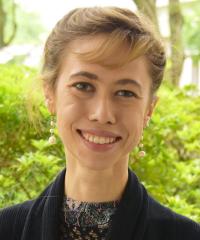You are here
Kristine Romich
California State University-Northridge
NASA Goddard Space Center Intern
NASA Goddard Space Flight Center
Position details
Coronal Heating and the Origin of the Solar Wind
Why is the Sun's atmosphere—the solar corona—so hot at a million degrees? Which regions of the hot solar corona are accelerated to become the solar wind, and how? These are fundamental, unanswered questions about the Sun and the solar wind in which the Earth lives, which Kristine is investigating through analyzing data analysis. Kristine is researching the basics of time series analysis and image processing by contributing to two research projects. The first is the analysis of a series of images of the solar corona to identify patterns in the coronal heating. The second is the analysis of plasma measurements of the solar wind to identify fluctuations in composition.
Final presentation
![]() Understanding Coronal Heating through Time-Series Analysis and Nanoflare Modeling
Understanding Coronal Heating through Time-Series Analysis and Nanoflare Modeling
Periodic intensity fluctuations in coronal loops, a signature of temperature evolution, have been observed using the Atmospheric Imaging Assembly (AIA) aboard NASA’s Solar Dynamics Observatory (SDO). We examine the proposal that nanoflares, or impulsive bursts of energy release in the solar atmosphere, are responsible for the intensity fluctuations as well as the megakelvin-scale temperatures observed in the corona. Drawing on the work of Cargill (2014) and Bradshaw & Viall (2016), we develop a computer model of the energy released by a sequence of nanoflare events in a single magnetic flux tube. We then use EBTEL (Enthalpy-Based Thermal Evolution of Loops), a hydrodynamic model of plasma response to energy input, to simulate intensity as a function of time across the coronal AIA channels. We test the EBTEL output for periodicities using a spectral code based on Mann and Lees’ (1996) multitaper method and present preliminary results here. Our ultimate goal is to establish whether quasi-continuous or impulsive energy bursts better approximate the original SDO data.
I earned my A.S. from Harold Washington College (HWC), one of the City Colleges of Chicago, in December of 2016. After I complete the undergraduate coursework, I plan to pursue a Ph.D. in astrophysics with the ultimate goal of a career in academia.
My previous research experience includes a summer 2016 REU (Research Experience for Undergraduates) in particle astrophysics at the University of Wisconsin - River Falls, where I analyzed light propagation through the South Pole’s IceCube neutrino detector. Back in Chicago, I worked with a professor at the City Colleges to measure the gravitational influence of the Sun using low-cost electronics — a project I named “Do-it-Yourself Astrophysics."
During my time at HWC, I was a math and physics tutor, as well as an embedded Learning Assistant for a calculus-based physics course. I also served as the vice-president of HWC's STEM Club and volunteered at Chicago’s Adler Planetarium. More recently, I took part in the NASA Community College Aerospace Scholars program, which gives students from two-year colleges an opportunity to explore a NASA facility and design a model Mars rover.
I have since relocated to the Los Angeles area and will be attending the California State University - Northridge this fall.

